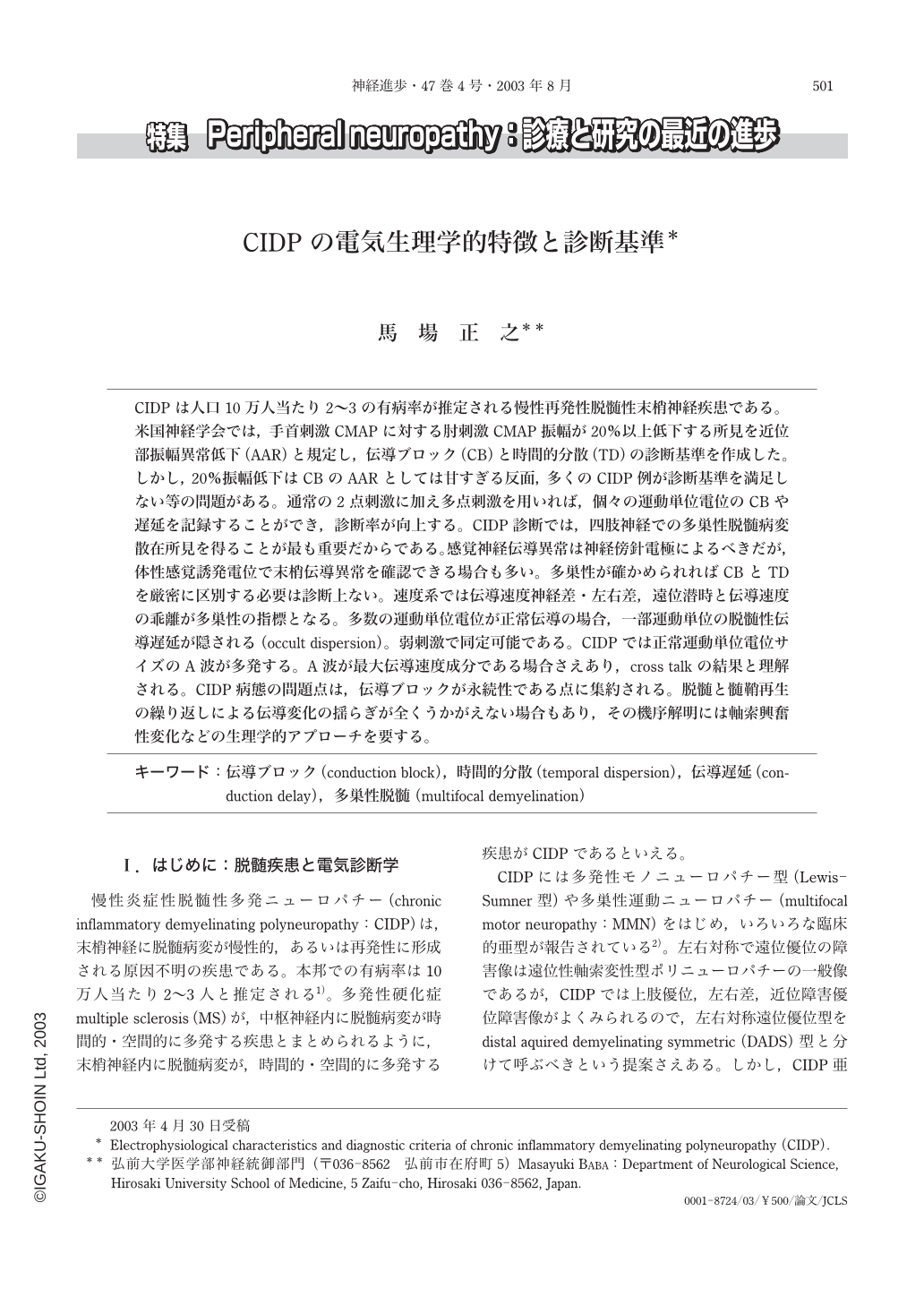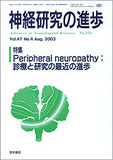Japanese
English
- 有料閲覧
- Abstract 文献概要
- 1ページ目 Look Inside
CIDPは人口10万人当たり2~3の有病率が推定される慢性再発性脱髄性末梢神経疾患である。米国神経学会では,手首刺激CMAPに対する肘刺激CMAP振幅が20%以上低下する所見を近位部振幅異常低下(AAR)と規定し,伝導ブロック(CB)と時間的分散(TD)の診断基準を作成した。しかし,20%振幅低下はCBのAARとしては甘すぎる反面,多くのCIDP例が診断基準を満足しない等の問題がある。通常の2点刺激に加え多点刺激を用いれば,個々の運動単位電位のCBや遅延を記録することができ,診断率が向上する。CIDP診断では,四肢神経での多巣性脱髄病変散在所見を得ることが最も重要だからである。感覚神経伝導異常は神経傍針電極によるべきだが,体性感覚誘発電位で末梢伝導異常を確認できる場合も多い。多巣性が確かめられればCBとTDを厳密に区別する必要は診断上ない。速度系では伝導速度神経差・左右差,遠位潜時と伝導速度の乖離が多巣性の指標となる。多数の運動単位電位が正常伝導の場合,一部運動単位の脱髄性伝導遅延が隠される(occult dispersion)。弱刺激で同定可能である。CIDPでは正常運動単位電位サイズのA波が多発する。A波が最大伝導速度成分である場合さえあり,cross talkの結果と理解される。CIDP病態の問題点は,伝導ブロックが永続性である点に集約される。脱髄と髄鞘再生の繰り返しによる伝導変化の揺らぎが全くうかがえない場合もあり,その機序解明には軸索興奮性変化などの生理学的アプローチを要する。
I.はじめに:脱髄疾患と電気診断学
慢性炎症性脱髄性多発ニューロパチー(chronic inflammatory demyelinating polyneuropathy:CIDP)は,末梢神経に脱髄病変が慢性的,あるいは再発性に形成される原因不明の疾患である。本邦での有病率は10万人当たり2~3人と推定される1)。多発性硬化症multiple sclerosis(MS)が,中枢神経内に脱髄病変が時間的・空間的に多発する疾患とまとめられるように,末梢神経内に脱髄病変が,時間的・空間的に多発する疾患がCIDPであるといえる。
CIDPには多発性モノニューロパチー型(Lewis-Sumner型)や多巣性運動ニューロパチー(multifocal motor neuropathy:MMN)をはじめ,いろいろな臨床的亜型が報告されている2)。左右対称で遠位優位の障害像は遠位性軸索変性型ポリニューロパチーの一般像であるが,CIDPでは上肢優位,左右差,近位障害優位障害像がよくみられるので,左右対称遠位優位型をdistal aquired demyelinating symmetric(DADS)型と分けて呼ぶべきという提案さえある。しかし,CIDP亜型相互間に本質的な病因・発症機序の違いがあるかどうかは明確でなく,神経伝導の面から見ると共通点が多い(表1)。したがって,現時点では,CIDPは原因不明の慢性再発性末梢神経脱髄症候群とまとめられている3)。一方,HIV感染やmonoclonal gammopathy of undetermined significance(MGUS)など,種々の免疫異常にCIDP類似の脱髄性ニューロパチーが随伴することも知られる。それらは広義のCIDPといえるが,原因不明のCIDPとは分けて考えるべきとする立場もある。病型による治療選択も模索されている4)。最近は特に糖尿病患者にみられるCIDPが患者数の多さゆえに注目されているが,病因的関連は不明である5)。
MS診断においては電気生理診断,すなわち各種の大脳誘発電位検査が重視されている。しかし,その診断的役割は補助的なものに過ぎない。一方,CIDP臨床診断においては,電気生理学的所見,特に運動神経伝導検査での脱髄性伝導所見の確認が必要条件である。慢性進行性末梢神経疾患の病因は多彩であるうえ,その多くを占める軸索変性型疾患とCIDPとを症候学的に区別することは困難な場合が多いからである。現在もっとも標準的とされる診断基準は,1991年に米国神経学会American Academy of Neurology(AAN)のAd Hoc委員会による診断基準6)だが,脱髄性伝導検査所見は診断上の必須項目に位置づけられている。
ヒト末梢神経への電気生理学的アプローチは,中枢神経の場合よりもシンプルかつ容易である。特殊な目的を除いて,CIDPでは標準的筋電図機器を用い,基本的かつ非侵襲的電気診断技術の組み合わせによって,微細な脱髄性伝導変化をみることが可能である。以下に,筆者らがこれまで多数のCIDP症例で観察した異常伝導所見を中心に,異常の発生機序および電気診断上の問題点を整理する。
CIDP is an idiopathic acquired demyelinating neuropathy characterized by chronic relapsing course. The prevalence rate in Aomori Prefecture of Japan was estimated as 2.2 per 100,000 in 1999. The diagnosis of CIDP from clinical picture alone may be possible, nevertheless, electrophysiological demonstration of disseminated demyelinative foci in the peripheral nerve is essential, since many axonal neuropathies has symptomatologic similarities to CIDP.
Abnormal amplitude reduction(AAR)of proximally evoked compound muscle action potential(CMAP)is a widely accepted index for diagnosis of acquired demyelination. Since diagnostic criteria of possible CIDP suggesting more than 20%reduction as AAR was published by the American Academy of Neurology(AAN),a word “conduction block” has been widely accepted as a diagnostic term rather than physiological definition. The AAN criteria have inevitably been met criticism if 20%reduction is too small for definite conduction block:some electrophysiologists insist that 40%to 60%reduction should be adopted. On the other hand, 40%of CIDP patients may not meet the AAN criteria. The sensitivity and specificity of AAN criteria may be, thus, not so high, because the criteria is based on a rough CMAP change after only two stimulation points study, wrist and elbow, or ankle and knee. To be convinced of multifocal demyelination, one can apply multiple stimulating points(inching technique)to search small foci showing CMAP change. Careful study with inching technique, conduction block of single motor unit potential or a group of some motor unit potentials could convincingly be demonstrated.
Conduction block in sensory fibers is more difficult to be convinced, since dispersed or small sensory compound action potential(CSAP)become easily unrecordable by surface electrodes. Near nerve recording is essential for it and often useful to demonstrate dispersed polyphasic CSAP of low amplitude. Somatosensory evoked potential is another powerful tool to reveal multifocal sensory involvement in the extremities.
Practically, to differentiate conduction block from temporal dispersion is not essential, since these two findings both indicate presence of demyelination or remyelination. When the CMAP changes are really multifocal, diagnosis of acquired demyelination is more convincing. When conduction abnormalities are uniform and generalized, the diagnosis of CIDP should be reconsidered, because uniform change in CMAP is a distinctive feature of inherited neuropathies. Discrepant fall in motor conduction velocity to relatively normal distal latency and the reverse are also frequent findings in CIDP.
Temporal dispersion by some delayed motor unit potentials can be hidden by majority of normally conducting motor unit potentials. Submaximal stimulation can revealed the occult dispersed units with relatively low threshold. When distal CMAP is dispersed and of low amplitude, proximal AAR may not meet diagnostic criteria of demyelination.
F-wave block is an odd finding, since disappearance of F-wave or decreases population of F-wave is often found in amyotrophic lateral sclerosis, or other spinal muscular atrophies, too. When F-wave block is an only abnormal finding, we have to wait for additional findings suggesting generalized denervation or demyelination.
In demyelinating neuropathies, complex a-waves are seen frequently. The size of a-wave in CIDP is sometimes as quite big as a normal motor unit potential. Complex polyphasic a-waves consisted of a few motor units are occasional findings. These features strongly indicate that a-waves are not originated from axon branching, but from cross-talk at demyelinative foci. Some late a-waves may have the fastest conduction, since they sometimes jump to right in front of main CMAP when strong stimulating current is applied.

Copyright © 2003, Igaku-Shoin Ltd. All rights reserved.


